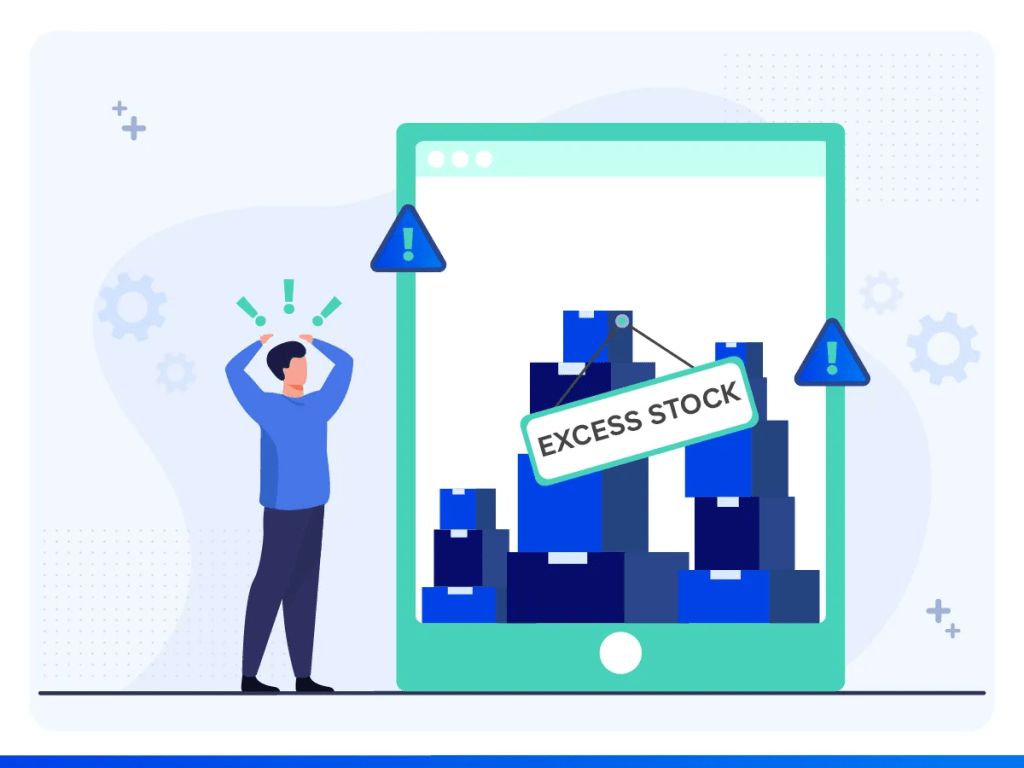Every business has merits and demerits, but that doesn’t mean you must endure huge losses for every demerit. A successful business rises from dust into the wind to soar high. Similarly, if you are in the dilemma of surplus inventory, this article will help you declutter your stocks to maximize cash flow. While these items can become a cluttered headache, they also present an opportunity to maximize profits and generate cash flow. You can turn your surplus inventory into a lucrative revenue stream with the right strategies.
Many businesses and warehouses face the problem of excess stock, but it’s essential to know different ways to gain profit from overstocked items, discontinued products, or returns. Excess stock can create different problems if not handled quickly and effectively.
What is Surplus Inventory?

Excess or leftover inventory implies products or materials that are no longer in demand or used in current business operations. Such items may pile up for several reasons, like excess stock due to inaccurate projection of the forecasted demand, products that may be out of season or discontinued products, or sometimes, the customers may return the products. Excess stock can be a considerable expense for your company since it consumes capital and space that could be used for other purposes. Strategically sell surplus inventory to generate continuous cash inflow and growth of your business.
Why is Surplus Inventory Harmful to Your Business?

- Cash Flow Constraints: Surplus Inventory holds up the working capital that can be utilized for other business opportunities or product manufacturing.
- Storage Costs: Storing excess stock can inflict additional warehouse space, utilities, and inventory management expenses.
- Obsolescence Risk: Some products have shelf lives, which makes them vulnerable to becoming obsolete or losing value over time. This makes it challenging to sell them at a profitable price.
- Opportunity Cost: Resources tied up in surplus inventory could have been better utilized for more profitable ventures or inventory.
- Regulatory Compliance: Certain industries may have specific regulations regarding storing and disposing of surplus inventory, which can add to the operational complexity and costs.
How to Maximize Profits from Surplus Inventory?

Discount Sales and Promotions: The most straightforward way to eliminate excess stock is through concise sales promotions and discounts. Customers may opt to buy these items due to promotions such as discounts, bundle prices, or limited offers. This strategy can work well with products with limited shelf life or seasonal ones that must be sold before the next cycle.
Online Marketplaces and Auctions: E-commerce sites like eBay, Amazon, and other specialist industry marketplaces are helpful in selling excess inventories. These platforms have a large customer base and features that allow those with products to list them for sale easily. Furthermore, auction formats can create an environment for competitive bidding that could increase your potential earnings.
Liquidation Services: Many companies provide ‘liquidation services,’ whereby they buy and sell overstock inventory. While you may have to settle for a lower price than what is offered in local retail stores, the services are favorable and a fast means of clearing large stock in the market. It is important to note that acquiring services from recognized liquidation companies can help you save significant time and money while at the same time guaranteeing you a constant inflow of liquid cash.
Retail Store Formats: One way to sell excess merchandise directly to the public is by opening an outlet store or clearance center. These dedicated retail spaces enable one to offer products at lower prices depending on the type and brand while controlling the selling processes. Outlets can also work as a trial-error platform for the introduction of new product lines or experimental offerings.
Employee Discount: Consider offering surplus inventory to your employees at discounted rates. This strategy helps you clear out excess stock and serves as an employee perk, boosting morale and engagement.
Subscription Box: Create subscription boxes featuring surplus inventory items, providing a surprise element and driving revenue streams. This way, you can kill two birds with one stone: promote both product and service while engaging a loyal consumer base.
Influencer Marketing: Influencer marketing is a must for every business. These influencers have the power to direct their already-based fan base to drive your sales. Collaborate with influencers or social media personalities to promote and showcase surplus inventory, tapping into their engaged audiences. Promote every service, product, campaign, advertisement, or giveaway through them.
Charitable Donations: Although it is not a direct way of generating revenue, donating surplus goods to charity organizations has benefits, such as offering a company a tax write-off and promoting the Company’s CSR. Many charitable organizations are happy to receive product donations, which they can use to help those in need or for their fundraising events.
Recycling and Repurposing: If a surplus inventory is unsaleable or cannot be donated, recycling or Repurposing can be the next good option. Certain materials or parts of the container may have some value in other markets or may have uses that are beyond the current product and can be reused in other products or packaging. Reusing not only increases the overall manufacturing output but also makes it more environmentally conscious and sustainable.
Best Practices for Effective Surplus Inventory Management

- Accurate Forecasting and Demand Planning: Make decisions based on data analytics, historical sales patterns, and market trends.
- Inventory Tracking and Monitoring: Track and check the expiration date of products and do regular audits.
- Update Regularly: Seek feedback from customers, employees, and industry experts to identify areas for improvement.
- Combine Coordination: Coordinate with different departments, such as sales, marketing, operations, and finance, to establish clear communication.
Conclusion
Surplus inventory is one of the biggest challenges faced by every product—or supplies-based business. By adopting and implementing these best practices and effective surplus inventory management strategies, your business can transform cluttered stockrooms into profitable cash flow streams. Regularly reviewing and optimizing your strategy can reap huge benefits and maximize the value of your surplus inventory.















